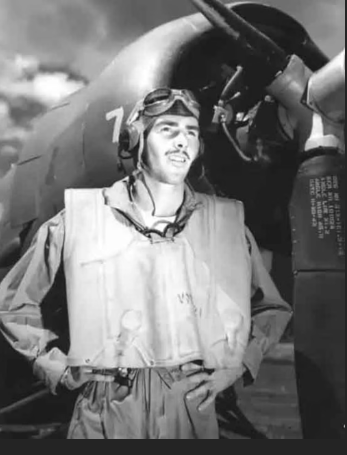
We have all watched those breathtaking World War II air battle footages where intrepid allied fighter pilots with superb airmanship and tenacious fighting spirit hurl themselves into action against superior-in-number enemy aircraft and shoot them out of the skies.
Well, several of these words are found in the Medal of Honor citation for Marine Corps Lt. James E. Swett who was awarded the Congressional Medal of Honor on October 12, 1943, for…
…extraordinary heroism and personal valor above and beyond the call of duty, as division leader of Marine Fighting Squadron 221 with Marine Aircraft Group 12, 1st Marine Aircraft Wing, in action against enemy Japanese aerial forces in the Solomon Islands area, 7 April 1943. In a daring flight to intercept a wave of 150 Japanese planes, 1st Lt. Swett unhesitatingly hurled his four-plane division into action against a formation of 15 enemy bombers and personally exploded three hostile planes in midair with accurate and deadly fire during his dive. Although separated from his division while clearing the heavy concentration of antiaircraft fire, he boldly attacked six enemy bombers, engaged the first four in turn and, unaided, shot down all in flames. Exhausting his ammunition as he closed the fifth enemy Japanese bomber, he relentlessly drove his attack against terrific opposition which partially disabled his engine, shattered the windscreen, and slashed his face. In spite of this, he brought his battered plane down with skillful precision in the water off Tulagi without further injury. The superb airmanship and tenacious fighting spirit which enabled 1st Lt. Swett to destroy seven enemy bombers in a single flight were in keeping with the highest traditions of the U.S. Naval Service.

Katie Lange, over at DoD News, has written another excellent “Medal of Honor Monday” article, this week on Lt. Swett.
The following are excerpts on Lt. Swett’s background:
Swett was born June 15, 1920, in Seattle; however, his parents, George and Nellie Swett, relocated to San Mateo, California, about three weeks later. Swett had two siblings, George and Margaret.
After Swett graduated from San Mateo High School, he attended San Mateo Junior College, where he took the flight training course twice under the Civilian Pilot Training program. Swett said he’d logged 450 hours by the time he decided to join the Coast Guard. When he went to a recruiter, however, he was persuaded to join the Navy instead, so on Aug. 26, 1941, he enlisted in the U.S. Naval Reserve as a Seaman 2nd Class.
Swett said he was in the top 10% of his class throughout training, so two months after he joined up, he was appointed as a Marine Corps aviation cadet. After completing flight training, he was commissioned as a second lieutenant in the Marine Corps Reserve on April 1, 1942, just a few months after the U.S. entered World War II.
While Lange does an excellent job of describing the actions that led to the award of the Medal of Honor to Lt. Swett, the Congressional Medal of Honor Society has produced a video in which a then-retired Colonel Swett tells it in his own words. The video also includes original World War II “action” footage.
To watch the video, please click HERE, scroll to the bottom of the Congressional Medal of Honor Society “page” on Lt. Swett and click on the video “James Swett World War II Medal of Honor recipient.”
After the war, Lt. Swett continued to serve in the Reserve until 1970, when he retired as a colonel.
According to Lange, Swett married his wife, Lois Anderson, around the time he left active duty. They had two boys, James Jr. and John, both of whom later became Marines.
After his wife passed in the late 1990s, Swett. In 2007, married Verna McPherson and settled in Redding, California.
“He also survived more than just the war; according to his obituary in Redding’s Record Searchlight newspaper, he beat prostate cancer and lymphoma, and he survived three car crashes,” Lange writes.
Col. Swett died of congestive heart failure on Jan. 18, 2009.
















